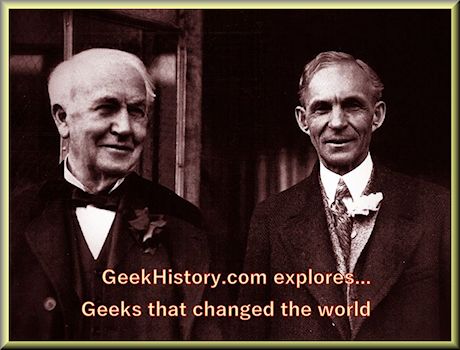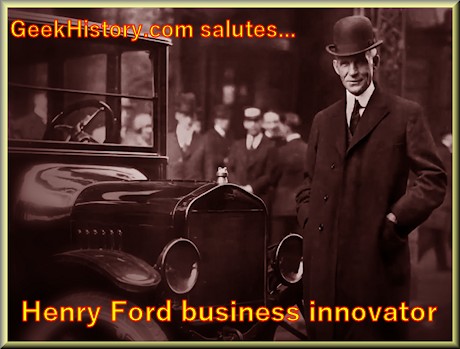 The legacy of Henry Ford and his mark on the world of technology in the modern industrial era is significant. There are numerous debates in the realms of geek history as to what credit should be given to Henry Ford and Thomas Edison for various inventions.
The legacy of Henry Ford and his mark on the world of technology in the modern industrial era is significant. There are numerous debates in the realms of geek history as to what credit should be given to Henry Ford and Thomas Edison for various inventions.
People point out that Edison did not invent the light bulb, he was simply a business man. Edison realized that experimentation and research takes money. Edison's first invention was the Universal Stock Ticker in 1869. Edison used the money he earned from the stock ticker to start his "invention factory." Edison paid workers to conduct numerous tedious experiments so he did not have to do the boring manual tasks himself. I think that is pretty genius.
Remarks are made that Henry Ford was not an inventor, he was an industrialist that sold automobiles. While it is true that Henry Ford did not invent the automobile or the assembly line, he perfected the assembly line to create lower cost automobiles, and create an industry.
During the modern industrial era from the mid 19th century to the early 20th the world was changing rapidly thanks in part to geeks like Thomas Edison and Henry Ford. Even if Henry Ford and Thomas Edison invented nothing their contributions to science and technology changed everything.
Henry Ford automotive designer
The son of a Michigan farmer, Henry Ford was a childhood geek who loved tinkering with machinery. When Henry turned 16 years old his father William arranged for Henry to stay with an aunt in Detroit. Henry hoped to find work where he could learn more about machinery. For more than a decade Henry Ford worked in various shops perfecting his skills as a machinist. Henry began working at the Edison Illumination Company as a steam engineer in 1891. After his promotion to Chief Engineer in 1893, Ford had enough time and money to devote attention to his personal experiments on gasoline engines.
Henry Ford built his first car, the Quadricycle, while he was employed at the Edison Illumination Company. Ford could have had a successful career in the electric power industry but left working for Edison in 1899 to start his own business of designing gasoline-powered automobiles. Ford assembled a team of 13 to form The Detroit Automobile Company. His original company failed because his investors pressured Ford to develop a luxury vehicle for the wealthy, as Ford stalled for time trying to perfect a lower cost vehicle he could sell to the masses.
On June 16, 1903, Henry Ford incorporated the Ford Motor Company. In October of 1908 Henry Ford introduced the Model T, with a four-cylinder, 20-horsepower engine, that could reach speeds of 40 miles per hour. The Ford Company started selling the Model T in 1908 at a cost of around $850. Constantly improving upon his assembly line mode of production Ford was able to decrease the price of a Model T to around $350 over an eight year period. Working to drive the cost of the vehicle down, Ford converted the automobile from an expensive curiosity into a practical conveyance. Henry Ford did not invent the automobile or the assembly line, but he developed and manufactured the first automobile that many middle class Americans could afford. By the end of the Model T's run in 1927, fifteen million had been built and sold.
Henry Ford business innovator The history of Henry Ford is an interesting study in innovation and capitalism. In 1914 Ford shocked the world when he raised the minimum daily pay from $2.30 to $5 for his workers. By increasing the workers wages he drove up wages in the local economy, help to create a middle class that could afford the products they manufactured. But the increase in wages had strings attached. The increase was not for everyone, it was a reward for the most productive workers who met the conditions of being a proper Ford employee. In an early form of big brother in the workplace, Ford established a Sociological Department to monitor employees habits beyond the workplace. In an early form of big brother in the workplace, the company established a Sociological Department to monitor employees habits beyond the workplace.
The history of Henry Ford is an interesting study in innovation and capitalism. In 1914 Ford shocked the world when he raised the minimum daily pay from $2.30 to $5 for his workers. By increasing the workers wages he drove up wages in the local economy, help to create a middle class that could afford the products they manufactured. But the increase in wages had strings attached. The increase was not for everyone, it was a reward for the most productive workers who met the conditions of being a proper Ford employee. In an early form of big brother in the workplace, Ford established a Sociological Department to monitor employees habits beyond the workplace. In an early form of big brother in the workplace, the company established a Sociological Department to monitor employees habits beyond the workplace.
Ford boasted that the "Five Dollar Day" would not simply reduce worker turnover, which was an increasing problem, it would increase business by allowing workers to be consumers of the products they made. The publicity and media frenzy over the workers pay increase created a tremendous amount of publicity for the Ford Motor Company, and transformed Henry Ford the businessman into a hero, as thousands of newspapers published his biography.
Although Henry Ford took full credit for the "Five Dollar Day" many attributed the idea to James Couzens, vice president and general manager of the Ford Motor Company. In 1915 Couzens resigned his position as general manager of the Ford Motor Company. James Cousins invested $2,500 as one of the original twelve investors of Ford Motor Company. Cousins his stock to Ford in 1919 for $29,000,000. Cousins went on to a career in politics, becoming mayor of Detroit in 1919 and a United States Senator in 1922.
In just a few short years the Ford Motor Company turned the original twelve investors into millionaires. Two of the original investors would go on to make a name for themselves in the automotive industry. As owners of one of Detroit’s large machine shops John Dodge and Horace Dodge were contracted to provide mechanical parts for Ford. The Dodge brothers contributed $10,000 in materials and cash to Ford. For ten years, the Dodge brothers' company was supplier to Ford. In 1913 the Dodge brothers terminated their Ford contract and devoted their energies toward producing a Dodge automobile. Henry Ford bought out the Dodge brothers of Ford in 1919 for $25,000,000.
Ford revolutionized transportation and American industry. By making the automobile affordable for the average American, and by shaking up the work force with new ideas on labor, Henry Ford profoundly impacted the landscape of the twentieth century,
The Legacy of Henry Ford
Henry Ford was not the first to attempt the production of low-cost, reliable automobiles. Henry Ford succeeded as the first to make cars affordable to average Americans with the Ford Model T. Ford's River Rouge factory become famous for their low-cost, standardized mass production. Ford's development of the assembly line allowed Ford to increase production from just over 32,000 cars in 1910 to nearly 735,000 cars in 1916. By the end of the Model T's run in 1927, fifteen million had been built.
Henry Ford and Thomas Edison were fellow geeks and lifelong friends, who loved to tinker with their gadgets. They were also business innovators with massive egos who became legendary heroes in their day. They knew how to dominate the spotlight and use their fame to promote their businesses.
Even if Henry Ford invented nothing his innovations changed everything.
In this chapter of geek history as we explore the lives of famous geeks we focus on the inventors as well as the inventions. In the next article we take a look at Henry Ford's Greenfield Village, a shrine to his life long friend Thomas Edison.
Learn more:
Learn about the manufacturing of the Model T Ford at the Ford Piquette Avenue Plant Detroit
